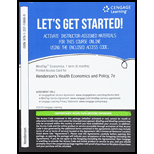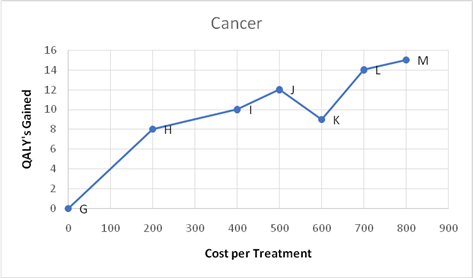
(a)
The dominant alternatives from the given treatments and the reason for them being dominant.
(a)
Explanation of Solution
The dominant treatment option for heart diseases is option F. Although it is the most costly option, it has the highest QALY value as well. Heart disease is something that could be considered will put an individual between life and death. Hence, having to spend more for a longer period of life would be worthwhile. Furthermore, option K could be considered dominant out of various cancer treatments. The cost of the treatment when compared with the QALY value seems reasonable. Due to the nature of the disease, a period of nine years at the respective cost could be considered worthwhile. Option R could be named as dominant under the infectious disease category. As the diseases are infectious spending a higher amount which also has a higher QALY value could be considered prudent.
Introduction:
The table shows the costs that must be borne in relation to various types of treatment for three selected diseases. Together with the costs the QALY figures are also given for each treatment option. A QALY or quality adjusted life year is a measure that takes into account the life expectancy in years together with an element of the quality of life, which is often not considered. The QALY measure ranges from zero which is equal to death to one which is considered perfect health.
(b)
The incremental costs, QALY’s and incremental cost effectiveness ratios for the most prudent treatment options.
(b)
Explanation of Solution
The incremental cost of option C under heart disease is the most rational choice. The incremental cost effectiveness ratio of it being 25 suggests that a patient would live another 33.3 years. This option seems more realistic as well as economically rational. Under the category of cancer, option H is the most rationale. A patient in this category could live another 25 years at an incremental cost of 200. Option O, the most rational choice under infectious diseases provides a patient with another 50 years to live at an incremental cost of 100.
Introduction:
The incremental cost effectiveness ratio is instrumental in providing a systematic means in obtaining certain health standards pertaining to an entire population subject to budgetary constraints. Given that the most effective treatment option is also the least expensive, it would be favorable for policy makers. On the other hand, if the most effective option is also the most expensive, policy makers would be brought into a challenging situation.
(c)
The graphical representation of various diseases.
(c)
Explanation of Solution
The graph for heart disease is as follows;

A heart disease being a decisive factor of life of a person is a disease where people opt to spend without hesitation. Hence, treatment option F could be considered a dominant option. Even the cost of it is the highest, so is the QALY value.
The graph for cancer is as follows;

The chance of survival of a cancer patient is considered minimal. Even after receiving the necessary treatment and controlling the spreading of cancer cells, it would still rise even after years. In that note, option K seems prudent, as its cost and the QALY value appears to be realistic.
The graph for infectious diseases is as follows;

As infectious diseases could create great harm to a society, it is prudent that all necessary measures are taken on a timely manner to prevent them from spreading. Hence, option R could be considered dominant.
Introduction:
To show the two dimensions of cost per treatment and QALYs gained for the three selected diseases, graphs are being used. The vertical axes of the graphs depict the QALY values for each treatment option under each disease. A QALY or a quality adjusted life year is similar to a measure of life expectancy that comes together with a quality element attached. There are instances in life where even the life expectancy is high; the quality of life is poor. The QALY measure has been developed in addressing this issue.
(d)
The best treatment strategy from the standpoint of public health.
(d)
Explanation of Solution
Different professionals as well as patients may carry varying viewpoints on priorities given to various treatment options and illnesses. However, when looked at it from the standpoint of the society at large, it could be said that illnesses that create an impact upon a larger fraction of the society should be given priority. Illnesses such as heart diseases and cancer are undoubtedly wide spread around the globe within the current context. However, they are not contagious diseases and thus the necessary treatment must be obtained at individual level. However, infectious diseases spread much widely at a higher speed. Further, due to their infectiousness, many people would be affected if necessary precautions are not being taken. Hence, option R would be the most prudent strategy. Although the cost of the option is high, amounting to 650, so is the QALY value.
Introduction:
Within any society, there are various types of diseases as well as numerous treatment options. The costs involved with such treatments differ. Together with the costs, the quality component of treatments that would be felt by the patients shall also change. Further, it would be much difficult for public health authorities to correctly identify what disease should be given priority as well as what treatment option should be promoted.
Want to see more full solutions like this?
Chapter 4 Solutions
HEALTH ECONOMICS+POLICY-MINDTAP
- Hospital has the following treatment options to reduce the incidence of Ventilator-Associated Pneumonia: For Treatment X (status quo), it would cost 50,000 with 40 percent effectiveness, For Treatment Y, it would cost 100,000 with 85 percent effectiveness, For Treatment Z, it would cost 75,000 with 65 percent effectiveness, and For Treatment V, it would cost 80,000 with 68 percent effectiveness. Is there any treatment option that is not economically rational? Explain. If the hospital’swilling to pay is $1000, which treatment optionwould it choose? Explain With technical innovation, suppose Treatment V increased its effectiveness to 75 percent, would your answer to question (a) above change?arrow_forwardMatch the following terms to their best definitions When a subject stops taking the assigned experimental treatment A.drop out B.drop in C.loss to follow up When a subject who is assigned to the control group starts taking the experimental treatment (perhaps by obtaining it outside of the study) A.drop out B.drop in C.loss to follow up When a subject is missing the study outcome A.drop out B.drop in C.loss to follow uparrow_forwardHospital has the following treatment options to reduce the incidence of Ventilator-Associated Pneumonia: For Treatment X (status quo), it would cost 50,000 with 40 percent effectiveness, For Treatment Y, it would cost 100,000 with 85 percent effectiveness, For Treatment Z, it would cost 75,000 with 65 percent effectiveness, and For Treatment V, it would cost 80,000 with 68 percent effectiveness. a) Is there any treatment option that is not economically rational? Explain. b) If hospital’s willing to pay is $1000, which treatment option it would choose? Explain. c) With technical innovation, suppose Treatment V increased its effectiveness to 75 percent, would your answer to question (a) above change?arrow_forward
- Which of the following is NOT true? Group of answer choices On average, most costs of medical school are covered by student tuition Most who get accepted into a medical school attend one. Most who attend medical school graduate Most who graduate medical school go into a residency programarrow_forwardThe opioid addiction crisis and its sequelae represent one of the worst problems to surface in the US in many years, with tens of thousands dying and billions of dollars in estimated costs each year across many domains, from employment to health care to criminal justice and beyond. Some say the problem is so large and growing so fast, we need a multi-disciplinary “all hands on deck” approach to addressing it, with the oft-suggested remedies centered around treatment and prevention. Though economics cannot cure addiction or save the life of someone who has recently overdosed on some substance or other, which of the following can and should health economists do to help? a. Evaluate the costs of doing nothing, i.e., the status quo, to show policy makers the scale of the resources we are implicitly devoting to unsuccessful strategy today, and thus to justify re-directing resources to more effective purposes b. Evaluate the cost-effectiveness of alternative treatment modalities…arrow_forwardAn empirically testable hypothesis for additional health care expenditure as an investment rather than as an expense is: a. If an increase in health care expenditure today results in an increase in productivity tomorrow, then health careexpenditure has an investment effect. b. If an increase in health care expenditure today results in an a rise in health care stock prices, then health care expenditure has an investment effect. c. If an increase in health care expenditure today results in worse health outcomes today, then health care expenditure has an investment effect. d. If an increase in health care expenditure today results in a more competitive health care market tomorrow, then health care expenditure has an investment effect.arrow_forward
- The fact that most medical care purchases are financed through insurance: a. has no effect on health care consumption because aggregate costs are the same regardless of payment method. b. reduces the amount of health care consumed by raising the price of additional units of care. c.has decreased health care costs and therefore reduced aggregate health care expenditures. d. increases the amount of health care consumed by reducing the price of additional units of care.arrow_forwardWhile randomized control trials are gold-standard, we don't use them in economics often to explore causal relationships. Why? Provide three reasons.arrow_forwardAs the newly appointed public health director in your county of residence, you are charged with increasing the healthcare utilization in your county. Document your high-level strategic plan by responding to the following: Summary: Who are the stakeholders in this situation?Analysis: What factors may impact the increase or decrease in health services supply and demand in your county?Recommendations: Provide an example of a supply and demand curve to describe the healthcare utilization in your county.Ensure that you integrate economic terms, frameworks, and models throughout your review.arrow_forward
- Compare and contrast two quantitative tools for decision-making in conditions of certaintyarrow_forwardWhich of the following would encourage consumers to economize on health care expenditures and producers to supply health care services more efficiently? Group of answer choices Decreased reliance on the purchase of catastrophic health insurance coverage and greater reliance on insurance with first-dollar coverage and small co-payments. An increase in the share of health care costs paid for by the consumer either directly or from a health savings account. Decreased reliance on personal health savings accounts and health care expenditures from the accounts. The establishment of a national health care system that would provide health care services to people free of charge.arrow_forwardSuppose we allocate a fixed budget for tuberculosis screening between two alternatives: screening the population generally, which has a marginal cost per test of MCG and a marginal benefit of MBG additional cases detected per test, and screening in homeless shelters, with a corresponding MCS and MBS. Assume it is currently true that MBG/MCG < MBS/MCS. Understanding that MB decreases (increases) as quantity increases (decreases) and the reverse is true for MC, we can conclude that: a. too much screening is being done at homeless shelters relative to general screening. b. too much general screening is being done relative to screening at homeless shelters. c. the price of screening in homeless shelters is too high. d. the allocation is already optimal if there is a fixed budget because we can’t equate the ratios of marginal benefit and marginal cost. e. we can only make the allocation optimal if the prices can be changedarrow_forward
